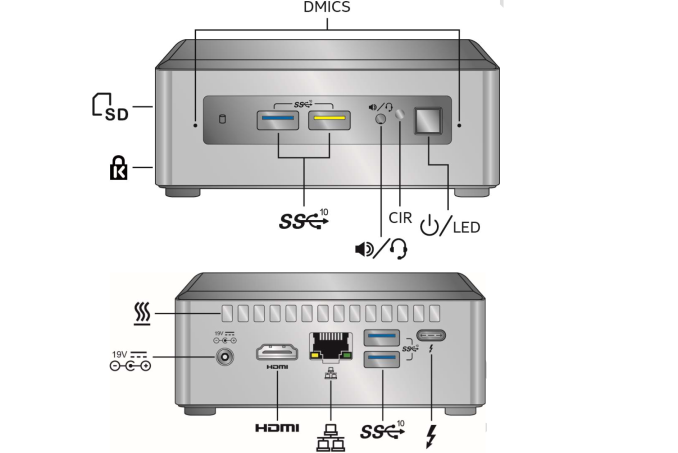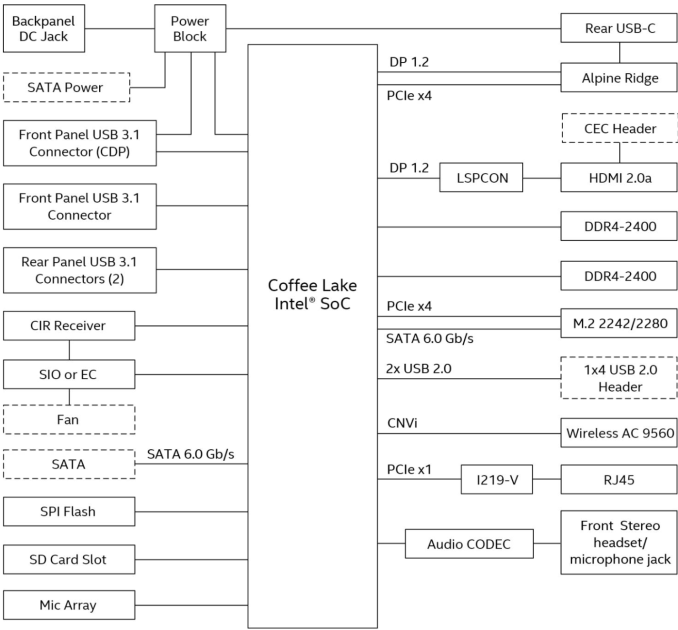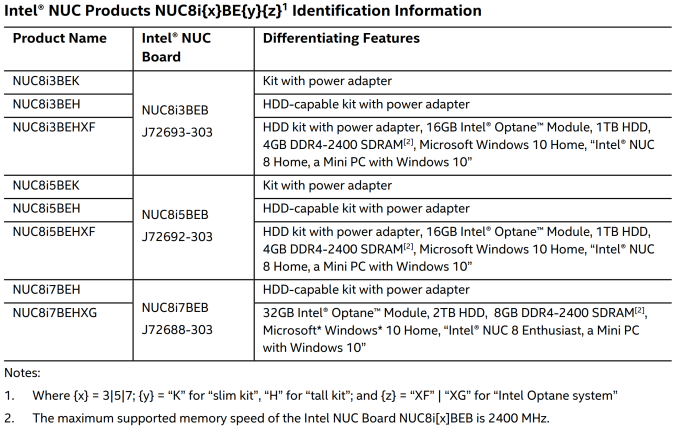Intel Officially Launches Bean Canyon NUCs with Coffee Lake-U Processors
by Ganesh T S on July 25, 2018 8:00 AM EST- Posted in
- Systems
- Intel
- HTPC
- NUC
- Iris
- Cannon Point
- Coffee Lake-U

Intel's Bean Canyon NUCs have been subject to a number of leaks, notably from FanlessTech. However Intel has finally made things official with a detailed technical product manual for all the members of the Bean Canyon NUC family. From an I/O perspective, the Bean Canyon NUCs look very similar to the Baby Canyon NUCs. However, the internals have gone in for a significant revamp, thanks to the Coffee Lake processors (CFL-U) inside. The updates include:
- 28W TDP processors across all SKUs, with true quad-core / octa-thread options
- Iris Plus Graphics 655 with 128MB eDRAM across all SKUs
- Intel Wireless-AC 9560 with Bluetooth 5.0 WLAN module
- USB 3.1 Gen 2 (10 Gbps) support on all external Type-A ports
While most of the Baby Canyon NUCs came with a 15W TDP processor - either in a "2+2" or "2+3e" configuration - all the Bean Canyon models (NUC8BE) sport 28W TDP processors (that can be configured to run with a lower TDP of 20W, if needed). The 28W TDP allows all the models to come with Iris Plus Graphics 655 with 128MB of eDRAM as the integrated GPU. This makes "2+3e" CPUs the new baseline, while even more powerful "4+3e" CPUs are now an option.
Since these are U-series processors, the PCH is on-package with the rest of the CPU. The move to the Cannon Point-LP integrated PCH allows for four USB 3.1 Gen 2 ports that are present as Type-A ports in the front and rear of the chassis. The CFL-U come with the new Integrated Connectivity feature (CNVi), where the Wi-Fi and Bluetooth MAC and other functional blocks are put inside the processor. The CRF (companion RF) module completes the Wireless-AC 9560 by implementing the signal processing, RF, and analog functions.
The Intel Wireless-AC 9560 is a significant upgrade over the Wireless-AC 8265 in the Kaby Lake NUCs. It comes with Wave 2 features, including support for 160 MHz channels and downlink MU-MIMO. The 2x2 WLAN module is theoretically capable of 1.73 Gbps bandwidth. It also integrates dual-mode Bluetooth 5 support.
| Intel Bean Canyon NUC PCs (Non-Optane SKUs) | |||||
| NUC8i7BEH | NUC8i5BEH | NUC8i5BEK | NUC8i3BEH | NUC8i3BEK | |
| CPU | Core i7-8559U 4C/8T 2.7 (4.5) GHz 28 W TDP |
Core i5-8259U 4C/8T 2.3 (3.8) GHz 28 W TDP |
Core i3-8109U 2C/4T 3.0 (3.6) GHz 28 W TDP |
||
| Graphics | Intel Iris Plus Graphics 655 | ||||
| PCH | Intel Cannon Point-LP for Coffee Lake-U | ||||
| Memory | Two SO-DIMM slots, up to 32 GB of DDR4-2400 | ||||
| 2.5" bay | 1x2.5"/9.5mm bay, SATA3 | None | 1x2.5"/9.5 mm bay, SATA3 | None | |
| M.2 Slot | Up to M.2-2280 SSD with SATA3 or PCIe 3.0 x4 interface | ||||
| Wi-Fi/BT | Soldered-down Intel Wireless-AC 9560(802.11ac 2x2 + BT 5.0) with WiDi support | ||||
| Ethernet | Intel I219V Gigabit Ethernet controller | ||||
| Display Outputs | DisplayPort 1.2 via USB-C connector HDMI 2.0 |
||||
| Audio | 3.5 mm TRRS audio jack 7.1 channel audio output via HDMI or DP |
||||
| Thunderbolt & USB-C |
1x Thunderbolt 3 Type-C (40 Gbps) (USB 3.1 Gen 2 and Display Port functionality included) | ||||
| USB | 4 USB 3.1 Gen 2 Type-A (10 Gbps), one with charging | ||||
| Other I/O | MicroSDXC card reader with UHS-I support One infrared receiver |
||||
| Size (mm) | 115 × 111 × 51 | 115 × 111 × 31 | 115 × 111 × 51 | 115 × 111 × 31 | |
| PSU | External, 65 W | ||||
Intel continues to use a LSPCon on board to convert the Display Port 1.2 output of the processor to a HDMI 2.0 port with HDCP 2.2. Unfortunately, stereoscopic 3D will not be supported. The good news is that the Thunderbolt 3 USB Type-C port on all the models will also support 4Kp60 displays with HDCP 2.2. All versions of the Bean Canyon will support Thunderbolt 3 (unlike the Core i3 version of the KBL-U Baby Canyon that restricted the Alpine Ridge Type-C port to USB 3.1 Gen 2 only in the firmware).
Similar to the previous NUCs, Intel plans to sell both kit (NUC8iXBEK / NUC8iXBEH) and board versions (NUC8iXBEB) of the different configurations. Note that the BEK does not support a 2.5" drive, while the BEH SKUs do. System builders using the BEB SKUs can opt to operate the processor in the cTDP down (20W) mode if adequate cooling is not available. Intel also plans to offer pre-built systems with Optane, as described below.
Retail availability is expected to be in early August. Pricing details are yet to be made available.
Source: Intel (PDF)















38 Comments
View All Comments
schizoide - Wednesday, July 25, 2018 - link
Sorry, meant the i7-8700t there.Lew Zealand - Wednesday, July 25, 2018 - link
35W desktop CPUs have no chance of working in a NUC unless Intel changes the cooling and the motherboard chipset. NUCs use laptop class CPUs and their associated lower power motherboard chipsets and sockets.The i5-8500t and i7-8700t are desktop-class LGA1151 CPUs which have never been the type of CPUs used in the 4x4" NUCs. That's why I said to look at other classes of units which use low power desktop class CPUs, Intel's offerings are laptop-class and have always been so.
There is no ~28W 4 core i3 laptop CPU from Intel, nor are there ~28W 6 core i5 or i7 CPUs. Intel could certainly redesign to add a better cooler and then pop in either the 45W laptop 4 (i3) to 6 (i5&i7) core units, or 35W desktop CPUs but that means a larger class of NUC sitting between these and the Hades Canyon ones. I'd love it if they made something like this but I'm not counting on it.
Lew Zealand - Wednesday, July 25, 2018 - link
But this yammering isn't addressing your source of annoyance. The only reason Intel released the 4 and 6 core i3s, 5s, and 7s at similar prices to lower core previous gen CPUs is because of Ryzen on the desktop.The only reason they *don't* need to extend those benefits to lower power chips on the laptop side (why *not* a 35W laptop 4-6 core?) is because Ryzen is not nearly the same threat in the laptop space. If that changes in the next year or two (very doubtful), then I'll wager that Intel will make and price those chips accordingly.
schizoide - Thursday, July 26, 2018 - link
Intel makes the CPUs, the chipsets, the motherboard, and the entire system. It's a fully integrated product. They could do whatever they want here, and they chose to limit the NUCs to pre-coffee lake core counts. That sucks, they should do better, and I'm a disappointed consumer who will not be purchasing one due to this mistake.Jaybus - Thursday, July 26, 2018 - link
They can do whatever they want EXCEPT defy the laws of physics.Lew Zealand - Thursday, July 26, 2018 - link
I see no mistake from Intel as you're asking for a product class that Intel has never made. The current 4x4" NUCs have the best CPUs in them that Intel offers in their 28W laptop class. You want something more which Intel is not interested in making so they lose a sale from you, but that's why I suggested Gigabyte or Zotac. They make USFF PCs with desktop class processors. For a price and size premium, unfortunately.As a point of reference, have a look at the core counts of the pre Coffee Lake NUCs. The i5s and i7s all have lower core counts and the i3s did not have Turbo Boost. Increased core count and i3 Turbo boost are new features of the Coffee Lake laptop CPUs and are among the many improvements in this year's NUC line.
Put another way: assuming that Intel would upgrade the i5 and i7 NUC from a 2 core to a 6 core CPU in one generation makes no sense.
wbwb - Monday, July 30, 2018 - link
From the article: there are things other than CPU cores on the U-series silicon, such as eDRAM, PCH, and Wi-Fi & Bluetooth. It's not a CPU, it's a SOC. Comparisons to CPUs with less integration are invalid.maroon1 - Friday, July 27, 2018 - link
This thing has Iris iGPU with 128MB ram